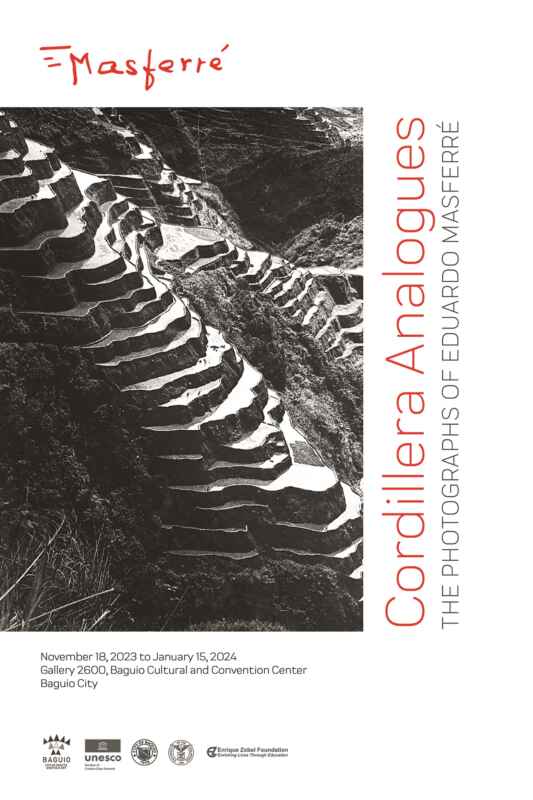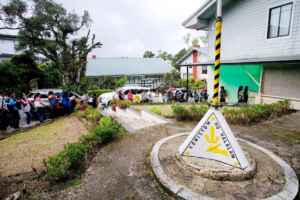IBAGIW CREATIVE FESTIVAL TO SHOWCASE MASFERRE PHOTOGRAPHS

A retrospective exhibit featuring the photographs of worldrenowned photographer Eduardo Masferré opens formally on November 17, 2023, as part of the calendar of activities slated for this year’s Ibagiw Creative Festival to mark Baguio City’s designation as a UNESCO creative city, now on its sixth year. The exhibit will carry the title “Cordillera Analogues: The Photographs of Eduardo
Masferré” and will consist of twenty-seven of Masferré’s most iconic photographs of the Cordillera.
This set of works will be displayed at the Gallery 2600 of the Baguio Convention and Cultural Center and will be open to the public starting November 18, 2023. The exhibit will run until January 15, 2024. Exhibit organizers say that this show will re-introduce Masferré’s works to wider
audiences in the Philippines, in Baguio City, and the rest of the Cordillera region since Masferré’s works today are only largely found and housed in his ancestral home and birthplace in Sagada, Mountain Province.
On the other hand, Masferré had also spent a significant portion of his life in Baguio City where he completed his secondary education. In the late 1940s, he served as the associate editor of a Baguio
newsweekly. The initiative likewise germinated from Masferré’s children who felt that their father had always wanted his works to reach generations of learners who needed a firm grasp on Cordillera history and culture.
Included in the exhibit are Masferré’s original captions and notes, as well as some of his personal photographic gear and appurtenances. Photographs taken of him by his assistants as he was on
photographic assignments will also be included. Curatorial notes will firm-up the context of the entire collection. The public will also have the chance to own a 12-postcard set of selected Masferré
photographs which will be up for sale during the duration of the exhibit.
Known for his compelling and pioneering photography of Cordillera culture, Masferré tapped on his artistic acumen to create a body of work that spanned more than twenty years of involved photographic work that took him on journeys to places in Mountain Province, Kalinga, and Ifugao.
Years later, his Cordillera photographs displayed in postcard sized prints at his Bontoc studio were
“discovered” by collectors, curators, and scholars who believed that his photographs clearly deserved to be brought to a wider audience.
Thus, began initiatives to organize national and international exhibitions of his works. Beginning in the 1980s, his photographs were exhibited at the Cultural Center of the Philippines, and later to
audiences in Copenhagen, Tokyo, and in Arles, France. A compilation of his photographs was published as a coffeetable book in 1988, and in 1992, he had a solo exhibition at the Smithsonian Institute’s Museum of Natural History in Washington DC, USA. This exhibit is presently archived at
the Smithsonian.
While it is a fact that his persona straddles two cultures on account of his parentage – born of a Spanish father and a Kankanaey mother, he was Sagada-born and, apart from a brief childhood sojourn in Spain, he largely spent the rest of his life in Bontoc and Sagada, and in the latter place
established a farm that served as a source of livelihood for him and his family. This native mindset had influenced his vision of the Cordillera. His photographs were characterized as “respectful, authentic, and natural.”
Roland Rabang
Lifestyle
VLOG CREATIVE MEDIA WORKSHOP, ISINAGAWA SA BENGUET
April 30, 2024
UNANG VINTAGE PHOTO BOOTH SA BAGUIO
April 30, 2024
TRADISYUNAL NA LARO, TAMPOK SA BIYAG FESTIVAL 2024
April 30, 2024
RESPONSIBILIDAD NG INDIGENOUS PEOPLE, TINALAKAY
April 30, 2024
FRONTMAN
April 30, 2024





